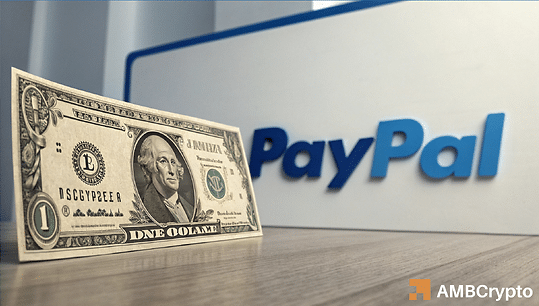In the latter part of 2024, PayPal’s USD token faced challenges that reverberated across the market for several reasons. It marked a significant moment as a traditional payment provider delved into the realm of Web3 in a way that had not been seen before. This move also signaled a new era for tokenized assets in the financial landscape.
Initially, there was great anticipation surrounding PayPal’s USD token. However, as time progressed, it became apparent that the buzz around tokenized assets was waning. Following its debut on the Solana network, the initial surge in performance gradually tapered off.
On August 25th, the market capitalization of PayPal’s USD token reached its peak at $1.01 billion. Since then, it has been on a downward trajectory, slipping below the $500 million mark by December, with the market cap currently standing at $515.17 million.
The decline in market cap for PayPal’s USD coincided with a decrease in its dominance on the Solana network.
Initially, PayPal’s USD token outperformed Ethereum in terms of market cap dominance on Solana. It reached a peak market cap dominance of 65.79% on August 29th, but by November 27th, this dominance had decreased to 25.42%.
It was observed that the overall performance of PayPal’s USD token market cap aligned with its dominance on the Solana network. This correlation highlighted that its viability within the Solana ecosystem was not sustained, as Ethereum controlled 67.21% of the circulating supply of PayPal’s USD token at the time of writing.
The Factors Behind the Initial Growth of PayPal’s USD Market Cap and the Current Shift
The decline in the market cap of PayPal’s USD token coincided with a period of increased demand in the cryptocurrency market. Between June 26th and August 30th, 2024, the token experienced a rally just before the market excitement peaked. At that time, there were more stablecoin holders, and the PayPal stablecoin offered appealing yields on Solana.
However, as the crypto market turned bullish, liquidity from yield miners may have been redirected into other cryptocurrencies, leading to a pullback in PayPal’s USD liquidity. Additionally, being a relatively new player in the market, PayPal’s USD token struggled to generate sustainable transaction volumes.
While these factors shed light on the liquidity decline of PayPal’s stablecoin, they should be viewed through a speculative lens. Despite the challenges, the stablecoin continues to exhibit significant on-chain activity. Notably, the circulating supply on both Ethereum and Solana has seen notable growth in the past 30 days.
For instance, there was a 5.31% increase in circulating supply on Ethereum and a 4.12% increase on Solana within the last 4 weeks. This uptick suggests ongoing demand for the stablecoin. However, its limited presence across only two networks has posed a barrier to wider adoption.

